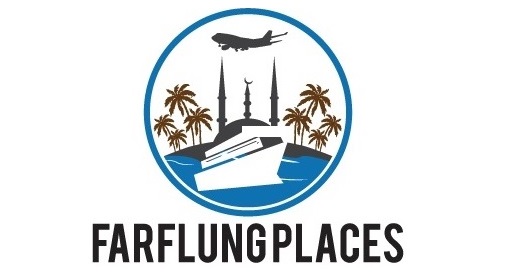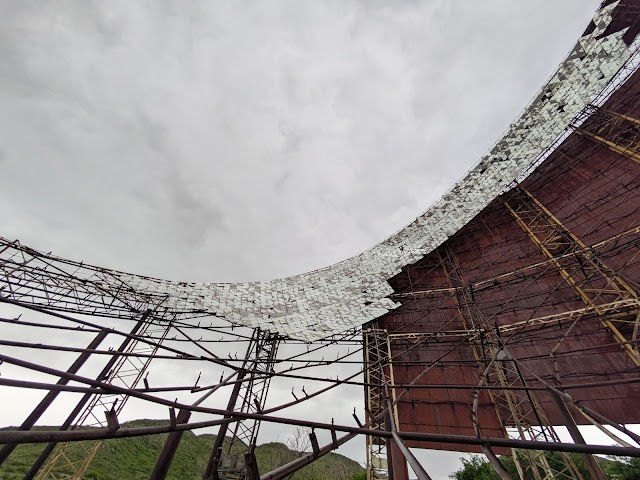The end of the Soviet Search for Extra Terrestrial life. The Abandoned ROT 54 Observatory
High up in the hills above Yerevan, the capital of Armenia, lies a large abandoned Soviet Scientific complex, the Aragats Scientific Centre. This was the site of the largest Deep Space Radio Telescope dishes in the USSR, which searched for life on other planets and played an important role in the Space Race.
Today, it is abandoned and slowly disintegrating, and although not open to the public, permission to visit can be granted by the Armenian National Body for Standards and Metrology; details on how to do this are in the 'Far Flung Tips' section at the end.
Mount Aragats is the largest mountain in Armenia, and in 1975, near the small town of Orgov, the USSR Space and Military started the building of the ROT 54 complex, containing antennas and dishes into the hillside, using many tonnes of explosives to enlarge the hole in which the main 54 metre radio optical telescope.
 |
| The Aragats Scientific Centre is in urgent need of repair |
It took until 1987 before it was operational, and it became the most important scientific observatory in the Soviet Union, used for research into deep space and searching for life beyond our planet. Under the tutelage of the Armenian Scientist, Paris Herouni, the complex flourished until the breakup of the Soviet Union in 1991, when all funding ceased.
Four years later, with new investment from both Russia and Europe, Herouni reopened the Observatory in the newly independent Armenia, and it continued its deep space research. Herouni's death and the immobilisation of the mirror due to substantial repairs being required led to its mothballing in 2012.
Since then, the site has continued to decay, and a secondary dish has all but vanished as its panels have been damaged by the elements. The main dish is still there, but the costs of repairing it to a working state are so large that it is unlikely to be operational ever again.
It is an easy drive, at least once you get out of the chaotic traffic in Yerevan. A small road leads up the mountainside where you pass the domes of the still-operating Byurakan Astronomical Observatory which is still operating and offering tours of its telescopes and gardens.
The road condition deteriorates as you approach the Aragats Scientific Centre, where you are met with a boom gate and a sleeping guard. We had already received permission to enter the centre, but this documentation still created confusion with the non-English speaking guard, who seemed reluctant to let us enter.
I was preparing to give up and just take some long-distance shots of the dish when he flung up his hands, opened the boom gate, and returned to his makeshift bed. The road now had clearly not been
 |
| The Research buildings are located behind the massive dish |
repaired since the 1980s, and required us to go slowly over the many rivulets that had removed the metalled top. Driving down terrible roads is just another benefit of having a hire car, as the punk poet John Cooper Clarke reminds us.
The dish dominated the mountainside into which it had been built. The entire scientific site was empty, except for a local couple going for a stroll with their newborn baby. Walking slowly around the dish, the rust and decay did not reduce the man-made beauty of the site, the dish panels reflecting the occasional burst of sunlight as a storm approached the top of the mountain.
The rest of the scientific site was in a much worse condition. A land-based dish had lost almost all of its panels, mirrored slivers of panel lying smashed on the ground due to bad weather and lack of repair rather than vandalism.
ROT54 is one of the more unusual spots to visit in Armenia, but totally worth it if you are an Urbex explorer, a fan of Soviet architecture, or just want to see the impressive remains of what was one of the world's largest Deep Space Radio Telescopes.
Far Flung Tips
* There are no tours (there should be! A chance of a local entrepreneur to step up), and public transport will get you nowhere near the complex, so you need to use a Yandex (will be expensive) or hire a car. We hired a car in Yerevan from Rent Motors, a local company, for a week for approximately US$30 per day. The car was an older model with a few scratches, but perfectly suited for driving around Armenia.
* Plan your trip early. You need to contact the National Body for Standards and Meterology a few days before your trip to gain permission. You will need to get proof that you have paid the 1500 AMD (per person) into their account. Easy to do, pop into an AMIO bank branch, there are many branches in Yerevan, and they will give you a receipt for the payment for 200 AMD. Send this to the Metrology board along with your explanation. Scientific Tourism is reasonable. You should get a positive response within 24 to 48 hours during weekdays.





0 comments